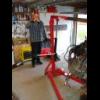Well, you will need to have the head off for a start. Hopefully that will be all. Get a new set of studs s they only withstand a certain number of fatigue cycles, and I have had them break on a recon engine. Check for visible damage to head and block faces, and absolute cleanliness. Obtain a new, genuine gasket.
At this point I am going to add something that has come to my attention just recently as a possible cause of head gasket problems. They are tedious and repetitive on this forum (we don't mind people asking about their problems, I mean more that it is unfortunately happening to too many people). That tells me that something is wrong. Every time the brand of gasket, the torquing up process, head skimming, etc are discussed, correctly. So it occurred to me that something is being missed. Have a look at the washers on the head studs. Do they look soft and somewhat chewed up? I have seen that so often, and never really understood the possible significance. I recommend Googling for "through hardened washer" or try here: http://shop.aseriess...rs-self-colour/
and procure a set of 9 or 11, depending on engine. It is 9 on yours, you may have to buy 10. They are 3/8" bore, Also, the coil bracket wants to go on top of the head nut, with a second half nut, as was done at one time. I would be inclined to get new nuts too.
Also, as a precautionary measure, while the studs are out use a countersink gently to remove any raised rim of metal or dirt around the stud holes in the block, and the same on the gasket face of the head. Make sure that the mating surfaces are perfectly clean and dry. Yes I know you most likely did all of that last time, just trying to be sure to cover everything.
You will want a Payen gasket (unless someone recommends a better brand), and torque up 10 ft lb at a time in the correct order, on clean, dry threads. By that I mean, do them all up to 10, then start at the beginning again, loosen the first nut very slightly, then nip it up to 20, same for the second, etc, always loosening the nut you are doing slightly before taking it to its next increment of torque. Finish at the correct torque for your engine. I have not got the manual to hand right now, but from memory it is probably 40 lb ft.
When that is done, the coolant replaced and valves adjusted, you can start it up, and run it up to full temperature. A short trip on the road is ideal. Then, with it still hot, back off the nuts slightly, one at a time again, and nip up to the full torque. check the valve clearances and adjust as necessary. Repeat after 500 miles.
If that does not provide a permanent cure you are going to need to have the block skimmed and possibly the block and head crack tested, but it is not common for Mini blocks to distort.



















